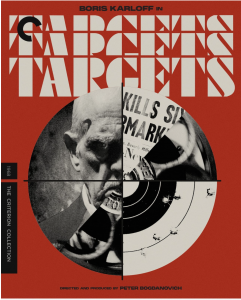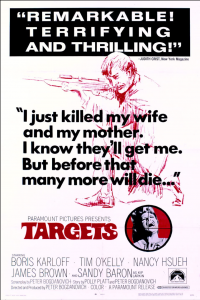



Jeff Godsil on the play adaptation Proof, from 2005, Natalie Lasko on The Happening, and in the DVD corner, the new Criterion Blu-ray of Targets, Peter Bogdanovich's thriller with Boris Karloff, from 1968.
–––––––––––––––––––––––––––––––––––––––––––––––-
Targets Criterion Film at 11 9 June 2023
Targets, Peter Bogdanovich’s first credited feature film as a director was timely when it was shot in late 1967 and even more grotesquely timely in 1968 when the film was released after the assassinations of Martin Luther King, Malcolm X, and Robert F. Kennedy. The new Criterion Blu-ray DVD of the film provides a wealth of information about the making of Targets, the career of Peter Bogdanovich, and even more important now, the influence of Bogdanovich’s then-wife, Polly Platt, not just on Targets, but on his career, and indeed later, on ‘70s and ‘80s cinema.
To someone interested in how individual movies even come about, the tale of Targets is fascinating. The story of its making is pure Sammy Glick movie hucksterism, but the goal is to position oneself to be able to do the work.
It began as a scheme by producer Roger Corman to exploit a financial deal with actor Boris Karloff, in which the performer “owed” Corman two days of shooting from a previous deal. Corman had come to like Bogdanovich and Polly Platt. In fact they have a knack for getting on the good side of numerous old- time directors such as Alfred Hitchcock, Howard, Hawks, and important to the conception of Targets, Samuel Fuller, and Fritz Lang. Corman wanted the team to take two days of Karloff footage, 20 minutes of his earlier Karloff film, The Terror, and 20 minutes of new footage, telling an entirely new story blending all these elements.
There were misfires along the way, such as not being able to figure out how to make Karloff a villain in the film, until flipping the template, and making him the hero, and inserting Karloff in the film, as an actor, as a version of the real person. Another unknown integer in the equation of Targets is the editor of Esquire magazine at the height of its importance as a cultural publication. Hayes had hired Bogdanovich to write for the magazine, just as he hired Robert Benton and David Newman as art directors and writers, and mentioned in passing to Bogdanovich that if he were to do a movie someday, it should be about the Charles Whitmore mass shooting in Austin, Texas – an idea that also came to fruition in a special section of an Esquire issue on "the new violence," designed and written by Benton and Newman.
Through a lot of thinking and worried organizing, these elements jelled, they wrote a script, did illegal guerrilla shooting on freeways and atop a White Heat-inspired oil storage tank, and at a drive-in, blending the sorrow of a long time horror actor at the end of his days, and the newfangled kind of anonymous and seemingly motiveless mass slayings by well-armed and well trained men whose crack up festers invisibly in their minds. Set an ugly Los Angeles reminiscent of near contemporary films, such as Whatever Happened to Baby Jane and Lady in a Cage, the movie feels like what we now see in Tarantino and P. T. Anderson, overlit LA municipalities, dense traffic, endless signage, and wide but eerily empty sidewalks, as if the Valley induced a genre of its own.
Targets is in the words of Richard Linklater, one of the greatest first films in American cinema history, and according to Polly Platt, arguably the first film by a film critic turned director.
Targets is lively and reflective, well-thought-through in terms of decor, to match the nature of the main characters, and marbled with people who will go on to be significant in their own right, including the producer of Cybil Shepard's TV show, here playing a drive-in theater snack bar clerk, and Frank Marshall, who went on to become one of the significant shareholders in subsequent cinema, and even the actor from M*A*S*H, Mike Farrell, who plays a victim in a telephone booth.
As part of its reflectiveness, Targets proves to be not only a movie partially about movies and movie making, but also about different ways of watching movies, and watching in general.
One of the themes of the film is "modes of viewing." Movies are seen here shown on a quasi big screen in a studio screening room, on television in a hotel room, and in the climax at a drive-in theater. But the villain in the movie’s, so to speak, modern half, Bobby Thompson, is also a watcher and views people most comfortably through the sight of a long range rifle. Putting distance between people, shooter and victim, the film argues that this is a new kind of inexplicable horror. It was a very typical Samuel Fuller-style idea when he suggested to the team that at the end, Bobby shoot at the cars through a opening in the big drive-in screen.
Bearing issue number #1179, and with a new cover by Drusilla Adeline/Sister Hyde, Targets coms, as the box reads, in a new 4K digital master, supervised by Bogdanovich, with an uncompressed monaural soundtrack.
Among the extras is an audio commentary track from 2003 featuring Bogdanovich, which has been on several DVD iterations of the film, but continues to be informative, and filled with tidbits of advice that Bogdanovich learned from his cozying up to film directors such as Hawks, Samuel Fuller, who said, save your budget up for the last scene, and Hitchcock, who told him never use your establishing shot to establish anything, save it for a dramatic moment.
There is a new video interview with filmmaker Richard Linklater, a lengthy account by the director of the background of Targets and its socio-political meaning, especially coming from a filmmaker based in Austin, Texas, where the Charles Whitmore slayings took place in the early 60s. He fully appreciates the clever if not genius move of blending the Gothic film that had been popular in the early ‘60s with a new kind of horror that was to take over America in the ‘70s and ‘80s on. I only disagree with Mr. Linklater on one point, that Bogdanovich was a great interviewer of other filmmakers. To me, he always sounds, bored, asking his routine questions in order from a clipboard, and not asking, follow-up questions, or engaging in dialogue, but then, maybe he just sounds that way.
Another repeat is an introduction to the film from 2003 by Bogdanovich, which also has appeared on several DVDs, and is shorter than the commentary track but still reiterates a few of the stories he tells there.
Then there is a healthy audio excerpt from a 1983 interview with Polly Platt at the American Film Institute, another informative chat by this fascinating but over-shadowed figure, who not only tells different stories about how Targets came to be, and how it was filmed, in only 18 days, which brings a gasp from the listeners, but is also unappreciated for her contributions to cinema history, among other things, while working on several James Brooks films, and also bringing Brooks together with Matt Groening, which led to the creation of the TV show The Simpsons.
Finally, there is an insert with an essay by the prolific Adam Nayman and excerpts from an interview with Bogdanovich from Eric Sherman and Martin Rubin’s 1969 book The Director’s Event: Interviews with Five American Film-Makers, published more or less contemporary with Targets.
Targets is well worth seeing and thinking about, holds up remarkably well, was under-appreciated in its day, and challenges the viewer in the ways of horror that are much more horrific than your average thriller. As Richard Linklater points out, we don’t like to think about the nature of evil in ordinary seeming people, and we don't seem to want our movies to be real. TV, maybe yes, with all of its true crime accounts, and semi documentary series, but not movies with their cartoon special effects violence.
- KBOO



